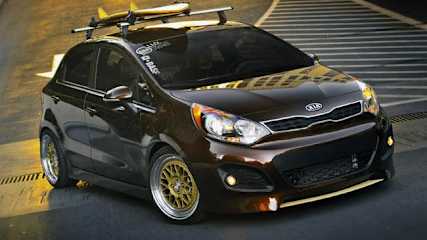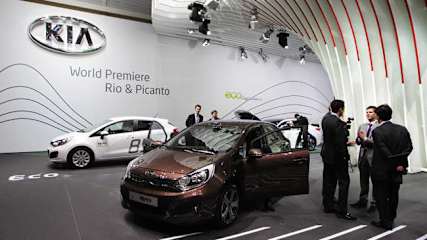Kia Rio 2016 News

Best new car deals for October
Read the article
By Chris Riley · 30 Sep 2016
Drive-away is the go when it comes to new car deals in October.

2016 Paris motor show preview
Read the article
By Craig Duff · 23 Sep 2016
The top end of town has snubbed next week's Paris motor show but the biggest auto event on the European calendar will have plenty of new sheet metal.

Kia Rio goes surfing at SEMA
Read the article
By CarsGuide team · 09 Nov 2011
The Kia concept was one of four outrageous models hown at the Las Vegas 2011 SEMA show.
The vehicles were conceived and built in-partnership with the popular lifestyle magazine, Antenna.
It's outfitted with everything the modern-day surfer needs for a perfect day and night at the beach, including an authentic Grain wood surfboard mounted on the roof.
The Rio 5-door has been lowered with a modified suspension for more aggressive handling, and the aggressive exterior design is accentuated by eye-grabbing 17-inch three-piece gold wheels, a stunning sunset-metallic golden-brown paint scheme, a custom body kit with a front splitter made of wood to match the surfboard on the roof and a redesigned rear fascia with center-mount dual exhaust.

Kia plans 1.1-litre diesel
Read the article
By Neil Dowling · 14 Sep 2011
Big-engined family cars are marking time as carmakers find new ways to make tiny engines do the same work.
Even engineers say the change over the past 10 years has caught them out. Few would have bet on a 2-litre, four-cylinder Falcon.
Kia’s powertrain manager in Europe, Dr Joachim Hahn, says the move to downsize engines wasn’t predicted a decade ago but clearly makes sense.
He is planning a 1.1-litre diesel engine for the Rio small car that will achieve a fuel economy of about 3.5 litres/100km - about half the current average for the small car class.
“Downsizing is a strategy we see as being the future,’‘ he says. Even the GT (Kia’s new large-car concept) will work well and lose little of its sporty nature when fitted with a 2-litre, four-cylinder engine.’’
The 1.1-litre three-cylinder diesel claims 85 grams/km of CO2 emissions - a figure that Dr Hahn says was “unachievable’’ 10 years ago.
“For us in Europe, getting small car emissions down gives us the freedom to make bigger cars - so maybe the GT can have a V8.’’
Kia experimented with its Optima when it entered the US market last year by dropping the V6 engine in its predecessor and offering only four-cylinder engines.
“We held our breath,’‘ he says. But no one complained. We replaced the V6 with a turbocharged four-cylinder engine and we had better than expected sales and customer feedback.’’
But Dr Hahn cautiond about taking the downsizing to far. “There are many variables,’‘ he says. Some markets expect performance from the car and a small engine will have to work so hard to meet expectations that any fuel economy benefit will be lost.
“For example, we could put the 1-litre, three-cylinder turbocharged petrol engine into the Cerato. But it may not suit al customers in all markets.”

Kia engine future
Read the article
By Neil Dowling · 07 Mar 2011
It's one new development that will be joined by an expanded range of turbo engines as Kia lures an increasingly sophisticated list of buyers. Under development is the three-cylinder turbocharged 1.2-litre petrol engine that Kia's German-based power train manager Joachim Hahn says will soon replace units of 1.6-litre and higher. That indicates there's a new direction for Rio and, for some markets, even the bigger Optima sedan.He clearly lays out a path for Kia that is high on engineering sophistication and with concentration on petrol - rather than diesel - power for the future. In arriving at the 1.2-litre, Mr Hahn - "it means 'cock','' he says by way of introduction - says Kia also developed a two-cylinder version."But though we could save a bit more fuel, it was noisy and had vibration problems,'' he says. "To fix the vibration we would have to put in balance shafts and that would increase friction and cost so we would have found more benefits in a three cylinder.''He says Kia has made significant changes in recent years as it developed new engines. "In the past few years we started quite strongly in diesels,'' he says. But we found new technology in developments such as the 1-litre, three-cylinder petrol engine for the Picanto (small car) that uses variable valve technology to maximise power and minimise fuel consumption and emissions."Consumers won't accept a lack of power in a small car. They also won't pay extra for new technology because small cars are generally price sensitive. So that rules out turbo-charging for the lower end of the market because it's too expensive."Diesel engines are also too expensive for the Picanto market. It can add about $3000 to the cost and customers won't pay that. "So, in the case of the Picanto's engine, it is a three cylinder with variable vales and a variable inlet manifold - this is relatively inexpensive technology that won't harm the price of the car.''The carmaker is also introducing bi-fuel - that's LPG and petrol - to its small-car range in some markets because it can slash missions. A Picanto, for example, with a bi-fuel engine can achieve a very low 90 grams per kilometre of CO2.Kia will add turbo-charging to many of its engines destined for the more expensive end of its market. "Turbo-charging is clearly on our road map,'' he says."Combined with direct-petrol injection, it is our new future.'' Kia makes a turbo-petrol engine for the Optima for the US market which has 200kW and a flat torque curve.Kia says that model will be considered for Australia but demand in major markets - such as the US - may push out its launch time. He sees a different type of turbo-charging for diesels and new challenges for petrol-fuelled engines."We are looking at downsizing the capacity of diesel engines,'' he says. "Normally, it is petrol engines that get smaller. Now we are looking at a smaller capacity diesel with two-stage turbo-charging. It's a high challenge but it s potential to further cut diesel fuel use and emissions.''One of the unexpected problems he sees for the near future is government regulation to reduce the amount of particulates - generally soot from an exhaust in a diesel vehicle - from petrol engines. "Petrol engines do produce particulates,'' he says."Now we believe that these may be targeted and tat means we have to apply more technology to future petrol engines. Previously this wasn't an issue for us. "It's just another challenge.''





